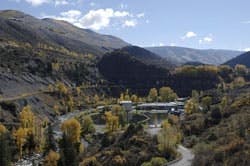Fast-Track Rehabilitation Projects Win Race against Time, Temperature and Tourists
Now, the facility has only two months out of the year—May and October—when flows are low enough to take components such as clarifiers and filters off-line for repairs.
“That’s why when I start looking at a major project—one that involves pulling process capacity off-line—I have to schedule it when I think I can hit those periods of minimum population that will result in minimum flows,” Anderson said. “Then, I need crews to hit the ground running.”
Rehab in the Rockies
When the new millennium arrived, some of the equipment at the Aspen plant had been in use for more than 30 years and was in need of serious rehabilitation .
“This was my first operation with USFilter,” Anderson explained. “I deal with contractors all the time, but the USFilter crew really impressed me. I was depending on them to get it done in time and they did—with time to spare.”
“The next year, with Filter Number Two, we also had a short window, but I was not as concerned as I was with the first one because Filter Number One was now able to accommodate as much flow as both filters has handled previously.”
Tackling the clarifiers
“Basically, with Clarifier Number One, the USFilter crew had to rip out every bit of the steel, all of the steel bridge and gear drive—the works. Everything had to come out of this clarifier except for the base of the center column, which provides the feed to the unit.”
Anderson allowed four weeks for the completion of the project, but the USFilter team finished in just three weeks.
According to Anderson, this “window” approach sped up the project and made it easier for the crew.
“Plus, when I got through, instead of rebuilding the wall with opaque blocks, I installed glass block in the space so now I’ve got a really great window that brings in natural light,” Anderson said.
No two alike
When it comes to retrofit and rehab projects , literally, no two are alike. Anderson has completed five rehab projects in the last five years, and with each individual project, there have been unique challenges—some physical, some mechanical, and some 100% local in nature (such as snow in July and extremely limiting time-frames).
“I’ve had three different supervisors on the jobs,” Anderson said. “Basically, five different operations, but each project turned out to be equally perfect. It’s quite a track record.”
According to Anderson, USFilter’s retrofit and rehab team is tops in the business.
“If I have a rehab project or I have something to do; ‘Can USFilter do this?’ that’s my first question.”
